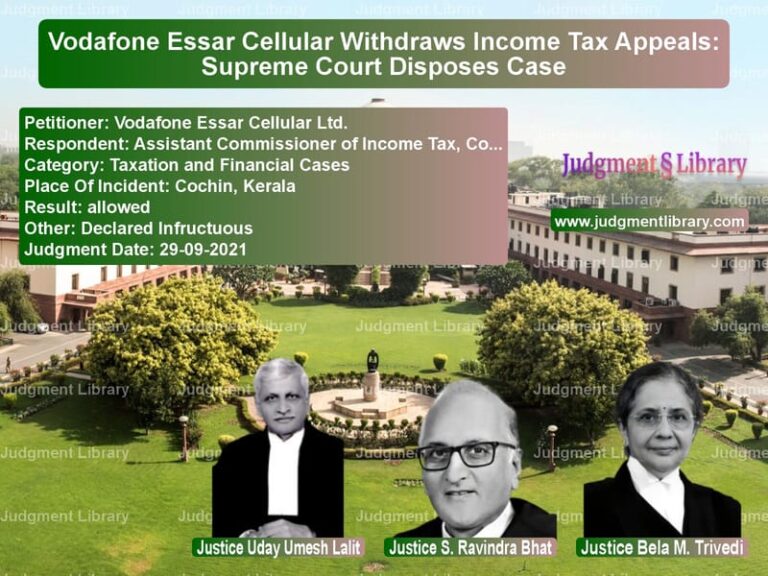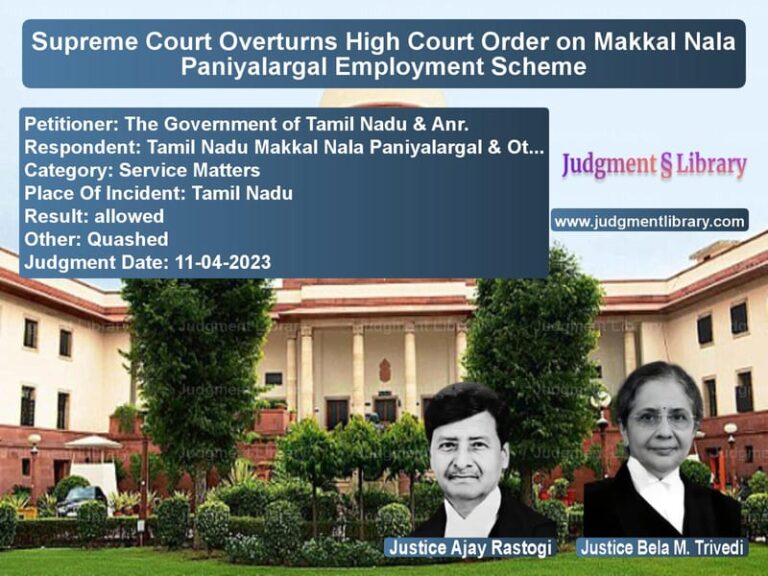Equal Pay for Equal Work: Supreme Court Mandates Revised Pay Scales for Teaching and Non-Teaching Staff
The Supreme Court of India, in its judgment in Secretary Mahatma Gandhi Mission & Another v. Bhartiya Kamgar Sena & Others, reaffirmed the principle of ‘equal pay for equal work.’ The Court held that non-teaching staff working in unaided educational institutions were entitled to the same pay scales as their counterparts in aided institutions. This decision is a landmark in labor rights and wage parity in the education sector.
This case emerged from a long-standing dispute regarding whether employees of unaided educational institutions were entitled to salary benefits and pay revisions recommended by the Sixth Pay Commission. The Supreme Court’s ruling upheld the Bombay High Court’s decision, reinforcing the fundamental right to equal treatment in employment.
Background of the Case
The dispute originated from a writ petition filed by Bhartiya Kamgar Sena, a trade union representing non-teaching employees of two engineering colleges run by the Mahatma Gandhi Mission Trust in Maharashtra. The union sought implementation of revised pay scales, which had been granted to employees in government-aided colleges but denied to those in unaided institutions.
The petitioners approached the Bombay High Court, arguing that there was no rational basis for such differentiation in wages. The High Court ruled in their favor, directing the implementation of revised pay scales. Aggrieved by this order, the management of the Mahatma Gandhi Mission Trust filed an appeal before the Supreme Court.
Key Issues Before the Court
- Should non-teaching staff in unaided institutions receive salary benefits recommended by the Pay Commission?
- Does restricting pay revisions only to aided institutions violate the principle of ‘equal pay for equal work’?
- Can private educational institutions be bound by government wage policies?
- What is the role of the All India Council for Technical Education (AICTE) in regulating pay scales?
Petitioners’ Arguments
The petitioners (college management) argued:
- Their institution was self-financed and did not receive any government aid, so they were not bound by government pay regulations.
- The Maharashtra Government’s resolution extending revised pay scales applied only to government-aided institutions.
- The AICTE had no authority to mandate pay scales for unaided institutions.
- The High Court’s interference was unwarranted since salary determination was a matter of contract between the employer and employees.
Respondents’ Arguments
The respondents (employees) argued:
- Employees performing identical work in aided and unaided institutions should not be paid differently.
- The State Government’s policy of restricting pay revisions to aided institutions was arbitrary and discriminatory.
- The AICTE’s guidelines for technical institutions should be applied uniformly to all institutions, irrespective of funding.
- The principle of ‘equal pay for equal work’ required that all employees performing similar duties receive equal remuneration.
Supreme Court’s Observations
The Supreme Court made the following key observations:
- The Maharashtra Government’s policy of limiting revised pay scales to aided colleges was arbitrary and violated Article 14 (right to equality).
- The concept of ‘equal pay for equal work’ applies to both aided and unaided institutions.
- The management of unaided institutions had already agreed in a settlement agreement in 2006 that future pay revisions would be implemented.
- Private institutions performing public functions cannot claim absolute autonomy in employment matters.
Final Judgment
The Supreme Court upheld the High Court’s ruling and directed the implementation of revised pay scales as per government regulations. The Court stated:
“Employees performing similar duties should not be discriminated against in matters of pay merely because of the source of funding.”
Legal Implications
- The ruling sets a precedent for fair treatment of employees in unaided institutions.
- It strengthens the role of AICTE and regulatory bodies in ensuring uniform employment standards.
- It reinforces the fundamental right to equality in employment.
- Private institutions may have to revise pay structures to comply with labor rights principles.
Conclusion
The Supreme Court’s decision in Secretary Mahatma Gandhi Mission & Another v. Bhartiya Kamgar Sena & Others is a landmark ruling that advances labor rights and wage parity in the education sector. By ensuring fair wages for employees in unaided institutions, the ruling upholds the principles of equal opportunity and non-discrimination in employment.
Don’t miss out on the full details! Download the complete judgment in PDF format below and gain valuable insights instantly!
Download Judgment: Secretary Mahatma Ga vs Bhartiya Kamgar Sena Supreme Court of India Judgment Dated 05-01-2017.pdf
Direct Downlaod Judgment: Direct downlaod this Judgment
See all petitions in Employment Disputes
See all petitions in Promotion Cases
See all petitions in Pension and Gratuity
See all petitions in Judgment by J. Chelameswar
See all petitions in Judgment by Abhay Manohar Sapre
See all petitions in dismissed
See all petitions in supreme court of India judgments January 2017
See all petitions in 2017 judgments
See all posts in Service Matters Category
See all allowed petitions in Service Matters Category
See all Dismissed petitions in Service Matters Category
See all partially allowed petitions in Service Matters Category







